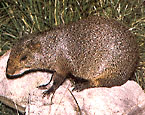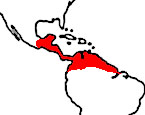|
Red-rumped
Agouti
(Dasyprocta leporina) |
||||
|
|
Physical
characteristics and distribution
|
|
Head
and body length of D. leporina is 415-620 mm and tail
length is 10-35 mm. Average weights range from 1.3 -4.0 kg.
Coloration varies between species, upperparts can be orange
to shades of brown to almost black and the fur is thick and
coarse with the longest hairs near the rump. The underparts
are pale white, yellowish or buff. Females have four pairs of
ventral mammae. D.
leporina is herbivorous, sitting upright on its hind legs
and holding food between its forepaws to eat. The diet consists
mainly of fruits, vegetables, and some succulent plants. |
|
Description
of the brain
|
|
Animal
source and preparation
|
|
All
specimens collected followed the same preparation
and histological procedure.
|
Other Related Resources (websites and publications)
List of Specimens | Explore Collections | Brain Sections | Brain Evolution | Brain Development | Brain Circuitry | Brain Functions | Location and Use | Related Web Sites | Contact Us | Search MSU Database | Personnel | Home



